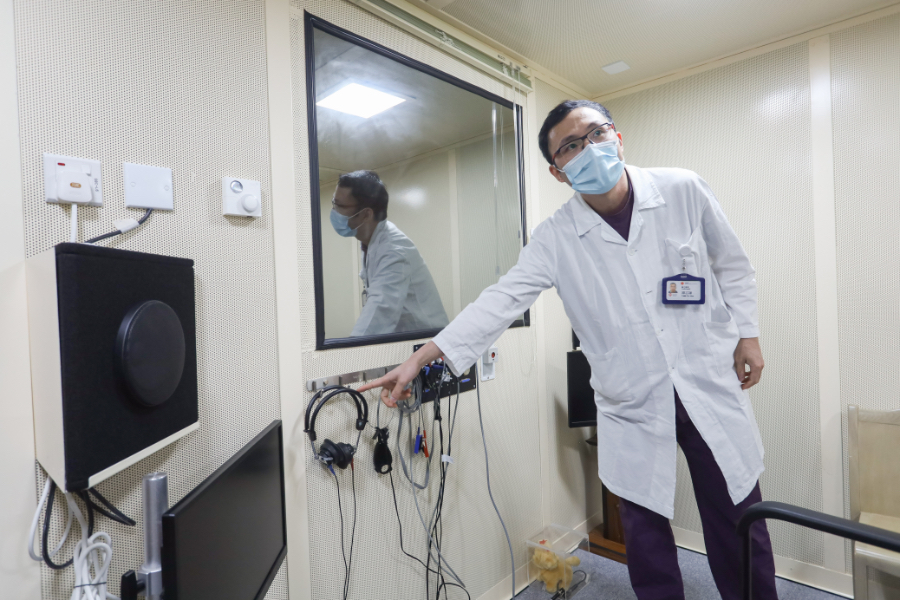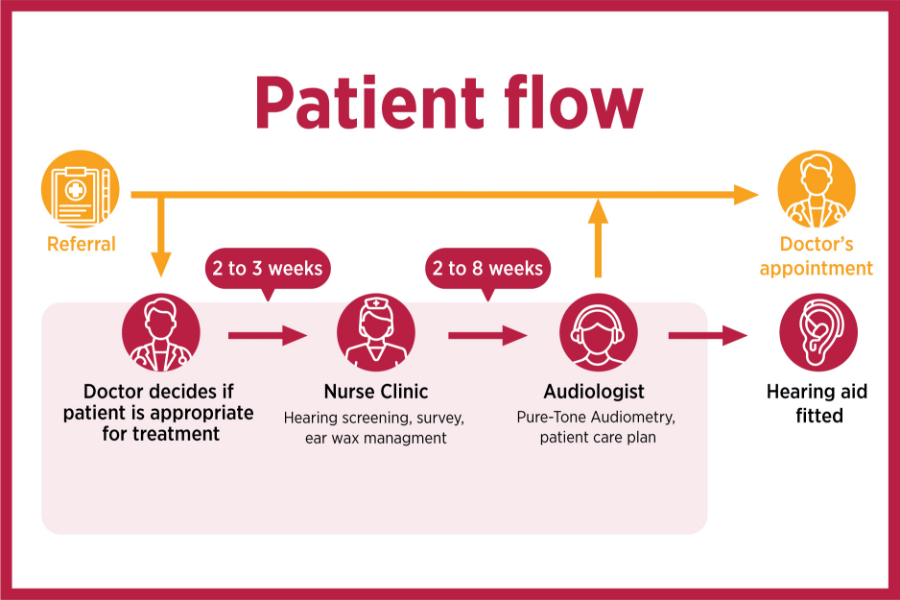Integrated Clinics end a world of silence for hearing impaired patients

Integrated clinics are being set up as one of the major approaches to reduce waiting times for Specialist Out-patient Clinic (SOPC). An Ear, Nose and Throat (ENT) Integrated Clinic was established in Queen Mary Hospital (QMH) and Tung Wah Hospital (TWH) of Hong Kong West Cluster (HKWC) in October 2020, allowing patients in stable condition to see a nurse and audiologist before their doctor’s appointments and to have their hearing issues resolved more quickly. The initiative has led to waiting times for a hearing aid to be fitted falling by as much as 20 months.
“One grandfather was living in an elderly home and he was always huddled alone in a corner. He wouldn’t respond to anyone, even if the staff asked him if he wanted a meal,” recalls Ng Yuk-shan, Ward Manager of ENT of TWH.
“It wasn’t until a colleague from Community Nursing Services noticed him in the home that he was referred to our clinic for treatment. He now finally has a hearing aid and his family members have been able to take him out to a restaurant for a meal. He is more optimistic.
“One grandfather was living in an elderly home and he was always huddled alone in a corner. He wouldn’t respond to anyone, even if the staff asked him if he wanted a meal,” recalls Ng Yuk-shan, Ward Manager of ENT of TWH.
“It wasn’t until a colleague from Community Nursing Services noticed him in the home that he was referred to our clinic for treatment. He now finally has a hearing aid and his family members have been able to take him out to a restaurant for a meal. He is more optimistic.
Patients used to wait for two years for a hearing aid
Dr Birgitta Wong, Chief of Service of ENT of QMH says the patient journey has been substantially improved. “Patients used to have to wait for two years for a hearing aid, but now it only takes four months,” she says. “Patients in a stable condition with a referral letter can be triaged to the Nurse Clinic for a preliminary assessment by a nurse. They then see an audiologist for hearing assessment. The audiologist will recommend an appropriate hearing aid for patients and lastly, they see a doctor.”
Nurses have been given training to prepare for the new arrangement, which results in more job satisfaction and higher capability to handle complex cases. Yuk-shan says nurses would refer patients to doctors immediately if they detect any abnormalities during their inspections.
The ENT Integrated Clinic for HKWC targets elderly people aged 60 or above, in stable conditions with hearing problems in both ears and have referral letter. Up to November 2021, over 3,400 patients had attended the clinic.
Nurses have been given training to prepare for the new arrangement, which results in more job satisfaction and higher capability to handle complex cases. Yuk-shan says nurses would refer patients to doctors immediately if they detect any abnormalities during their inspections.
The ENT Integrated Clinic for HKWC targets elderly people aged 60 or above, in stable conditions with hearing problems in both ears and have referral letter. Up to November 2021, over 3,400 patients had attended the clinic.

Strengthened communication with patients
Dr Wong says feedback from patients and their families has been overwhelmingly positive with nearly 90% saying they were satisfied with the service provided. Yuk-shan says it is grateful to see patients’ smiley face.
The clinic has not only shortened waiting times for patients but also led to enhanced communication between healthcare staff and patients.
Tam Chi-him, Audiologist of QMH, says clinic staff would assist the patients to adjust the volume of the hearing aids and adapt to them. There used to be a delay between patients having hearing aids fitted at the Audiology Centre and follow-up consultations. “Patients would have follow-up consultations six to nine months after seeing the audiologists,” he recalls. “We could not know whether the hearing aid was suitable for them. But now, patients have follow-up consultations sooner so we can find out about any problems. As a result, they are more likely to use their hearing aids and will be more satisfied with them.”
They agreed the Integrated Clinics have improved communications between patients and medical staff. “I saw a 97-year-old patient having her ears syringed on her own pillow while nurses chatted to her. That made me realise she felt comfortable and confident in our service. This service model is a bridge between patients and staff,” says Dr Wong.
The clinic has not only shortened waiting times for patients but also led to enhanced communication between healthcare staff and patients.
Tam Chi-him, Audiologist of QMH, says clinic staff would assist the patients to adjust the volume of the hearing aids and adapt to them. There used to be a delay between patients having hearing aids fitted at the Audiology Centre and follow-up consultations. “Patients would have follow-up consultations six to nine months after seeing the audiologists,” he recalls. “We could not know whether the hearing aid was suitable for them. But now, patients have follow-up consultations sooner so we can find out about any problems. As a result, they are more likely to use their hearing aids and will be more satisfied with them.”
They agreed the Integrated Clinics have improved communications between patients and medical staff. “I saw a 97-year-old patient having her ears syringed on her own pillow while nurses chatted to her. That made me realise she felt comfortable and confident in our service. This service model is a bridge between patients and staff,” says Dr Wong.
